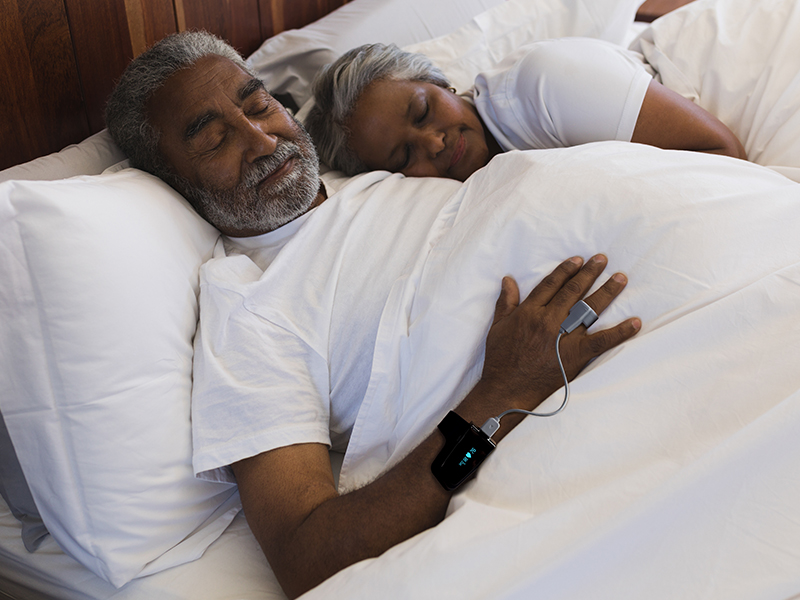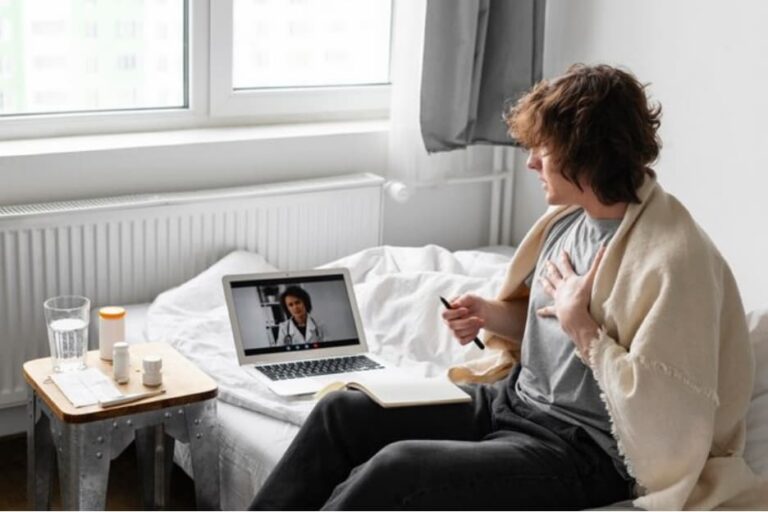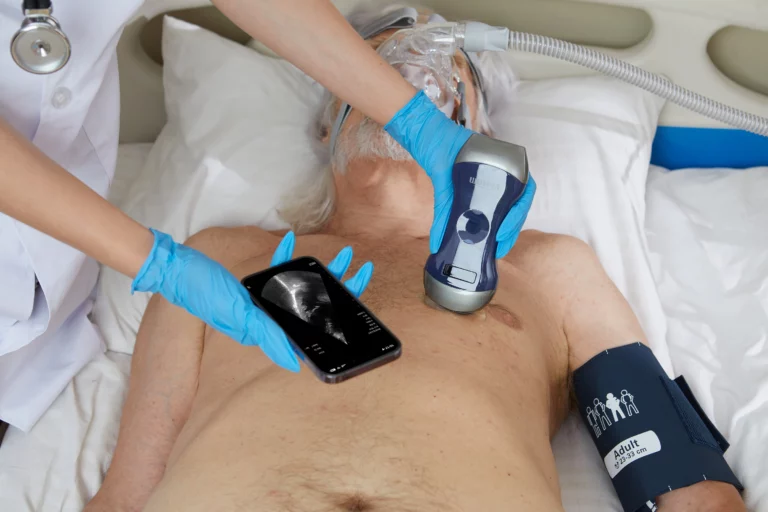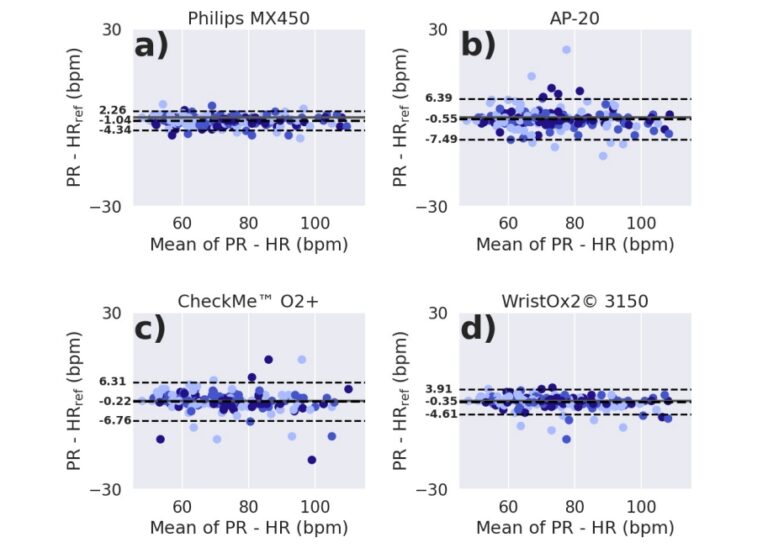As the harm of OSA has received increased attention, the choice of treatment therapy has become a priority for healthcare providers. While traditional CPAP therapy which maintains airway opening by forced air pressure is the established gold standard treatment, its acceptance rate is less than ideal due to the discomfort it can cause. Being much less burdensome than CPAP, oral appliance (OA) is emerging as a significant advancement in OSA care thanks to its enhanced patient compliance and salient curative effect. In this article, we will take a further look at the OAT devices and evaluate these two methods with the accurate monitor—pulse oximeter.

Two Common Types of Oral Appliances
Mandibular Advancement Devices (MADs)
Mandibular advancement devices (MADs) are designed to enhance the pharyngeal area by moving the jaw forward and down, which stabilizes the jaw and hyoid bone to prevent airway blockage. It primarily affects the velopharyngeal area to increase the rigidity and space within the pharyngeal region, repositions the soft palate, and enlarges the lateral pharyngeal walls, significantly reducing snoring. MADs also reposition the hyoid bone and balance the suprahyoid muscles, increasing the upper airway’s volume and permeability, and reducing pharyngeal collapsibility by reorienting pharyngeal fat pads and tongue muscles.

Tongue Retaining Devices (TRDs)
Tongue-retaining devices (TRDs) are also called tongue-stabilizing devices. They treat OSA by pulling your tongue forward using suction. A suction bulb secures the tongue, with the TRD’s tip remaining external to the mouth during sleep. Like MADs, TSDs open your airway by moving the base of your tongue forward.
OSA patients with few or no teeth or who cannot tolerate mandibular advancement devices may utilize TRDs instead. The appliance is composed of soft, flexible materials for nighttime comfort.
Treatment Efficiency of Oral Appliance Therapy
Statistic analysis from experiments indicated that the efficiency rate of MAD is higher than TRD in mild OSA. Although it is not significant in moderate and severe OSA, MAD efficacy is higher than TRD in both moderate and severe OSA. The reason is that the effect of MAD is not limited to a certain segment but has a marked expansion from the velopharynx to the glossy pharynx for multi-site obstruction. However, TRD works to improve the base of tongue collapse and activate the pharyngeal muscle response, meanwhile, the efficacy in blocking extra-base tongue collapse is suboptimal.
Latest Updates about Oral Appliance Therapy
Vivos Receives FDA 510(k) Clearance[2]
After receiving FDA 510(k) approval, Vivos Therapeutics, Inc.’s detachable CARE (Complete Airway Repositioning and/or Expansion) oral sleep apnea appliances for severe cases reached a milestone. It redefines oral appliance therapy while presenting a viable alternative to CPAP and surgery for severe OSA patients. The clearing includes DNA, mRNA, and mmRNA appliances that progressively relocate the hard and soft tissues in the airway for better functioning.
With an average treatment length of 9.7 months, the experiment carried out by medical sleep specialists showed that 80% of severe OSA patients experienced an improvement of at least 1 classification or at least a 50% improvement in the Apnea Hypopnea Index (AHI), a key OSA severity indicator. The first oral mouthpiece for sleep apnea to get FDA clearance for moderate and severe OSA in adults suggests this non-invasive therapy may be more widely applicable. Vivos establishes a new standard in treating a complicated ailment and opens the door to more accessible, curative choices for severe OSA patients via technology improvements.

myTAP Availability through Sleep Doctor[3]
The myTAP Oral Appliance is now available via Sleep Doctor. It is a major advancement in oral appliance therapy. In 2022, myTAP was shown to equal the effectiveness of custom-fitted TAP devices, indicating the potential for rapid therapeutic effects. It is FDA-approved for treating snoring and OSA while providing fast, personalized therapy. The oral mouthpiece for snoring fits in 15 minutes and has tray technology for simple warming and modifications to keep a perfect fit.
For patients pursuing a non-invasive treatment that can be customized without worrying about the cost and pain caused by bespoke devices, this oral appliance for sleep apnea can offer both flexibility and comfort. The cooperation with Sleep Doctor also uses virtual healthcare platforms to render this therapy more open to patients. United Healthcare’s recent policy modifications favor oral appliance therapy above surgical tactics for moderate to severe OSA. It highlights this therapy’s expanding significance in sleep medicine.

Day/Night and Mandibular-Repositioning Nighttime Appliance Use[4]
OSA patients with severe instances may benefit from recent oral appliance therapy advances, including Day and Night (DNA) and Mandibular-Repositioning Nighttime (mRNA) appliances. These devices increase airway volume and lower the apnea-hypopnea index (AHI). It is done by repositioning the jaw and enlarging the maxillary area.
In extensive research, the DNA appliance reduced AHI by 52.8% and the mRNA appliance by 49.2%. This method makes a breakthrough to modify the upward airway predominately via maxillary expansion, which in turn enhances trans palatal width and airway volume. These results indicate the possibility of patient-specific dental appliances for sleep apnea therapy to treat severe OSA using unique appliance designs, a breakthrough.
Exceeded Number of Patients Treated by SomnoMed[5]
SomnoMed announced that their oral appliance therapy has treated over 860,000 patients globally in their latest quarterly activity report ending December 31, 2023. This milestone shows SomnoMed’s Continuous Open Airway Therapy (COAT) technology’s efficacy and rising acceptability in treating OSA. In addition, SomnoMed has been strengthening device accuracy and comfort.
For example, by applying digital scanning and 3D printing technology, custom-fitted appliances are more accurately forged for better patient adherence and treatment success. SomnoMed’s devices, including Rest Assure, use innovative technology to assess treatment success in real time, giving patients extensive expertise and tailored solutions. These technological progressions boost patient satisfaction and awareness of sleep apnea and treatment.
Have a Closer Look at the Battlefield: Oral Appliance vs. CPAP
The updates above demonstrate a clear trajectory of progress in the field of oral appliance therapy, highlighting its ongoing development and the increasing advantages it offers over traditional treatment methods. However, whether OAT or CPAP, patient preference plays a vital role in determining the effectiveness of the therapy. For example, patients who value treatment efficacy above comfort may choose CPAP since it keeps the airway open all night. Conversely, OAT is favored by active travelers or those who value portability and comfort of use. Read on to delve deeper into the differences between OAT and CPAP. For a quick overview, please refer to the comparison sheet below.
Treatment Mechanism
The mechanism of oral appliance and CPAP treatment varies momentously. A CPAP machine takes in room air, then filters and pressurizes it before delivering it through a tube and into the patient’s mask. The continuous flow of air gently keeps the airway open, which is suitable for all OSA severity levels. Nevertheless, oral appliance therapy is designed to intervene in the narrowing or collapse of the pharyngeal wall. Whether by moving the jaw or by pulling the tongue, this kind of mechanical behavior clears the possible physical blockage and opens the upper airway, allowing for smooth breathing during sleep.
Comfort
Studies indicate that the compliance rate for oral appliances is approximately 90%, in contrast to CPAP therapy’s compliance rate of about 50%.[6]CPAP devices necessitate the wearing of a head-mounted mask connected to the device via tubing. To accommodate various severity of OSA and individual wearing habits, CPAP devices are equipped with different mask types. For oral appliance users, their devices are smaller in size and less restrictive, allowing for free movement during sleep.
Noise
Considering the quietness during sleep, CPAP machines may consistently be noisy throughout the night due to their operational mechanics. CPAP machine’s compressor draws in and filters room air then pressurizes it to deliver continuous airstream into a flexible tube[7]. The airstream processing together with the moisture evaporating in the water box inherently produces some level of noise during the use of the electricity-driven CPAP machines. Modern CPAP machines have claimed to reduce noise levels to less than 30 dB, but some may still find it disruptive during the night for the user and anyone sharing the bedroom. On the contrary, unplugged oral appliances operate silently by mechanically pulling airway muscles, therefore ensuring high sleep quality both of patients and of their bed partners.
Adjustability
CPAP machines are ready-made products and offer “conditioned” adjustability. On a CPAP machine mainframe, the ramp time, air pressure, and humidity level of the airstream are open to be adjusted to align with the varying OSA severity of different patients or their evolving symptoms. Modification of these parameters requires the repetition of titration tests during HSAT, and each parameter is quantified by sleep specialists. OAT devices, including MADs and TRDs, are custom-fitted to match a patient’s unique anatomical structure and comfort preferences.
Portability
Oral appliances undoubtedly stand out in the competition of portability thanks to their compact size and unplugged traits. These small acrylic devices are lightweight and easy to pack up, making them convenient for travel and other uses outside of the home. On the contrary, one CPAP machine usually contains a mainframe, a water box, a tube, and a facial mask, and it requires electricity to operate. Thankfully, advancements in design have led to more portable CPAP models that are increasingly light in weight and travel-friendly.
Cost
For those with a tight budget, oral appliance is a cost-effective alternative to CPAP machines. The usual price of a CPAP machine is typically between $500 and $1000. Meanwhile, oral appliances, including MADs and TRDs, are available at a range of $5 to $150, differing in material, brand, etc. Tailored solutions may become more expensive to accommodate individual situations. Notably, considered durable medical equipment (DME), some customized oral appliances through dentists can be billed under patients’ medical insurance, making it a more economical choice for patients seeking treatment for OSA.
Side Effect
User experience and adverse reactions should not be neglected when choosing between CPAP and oral appliance therapy. Although effective, CPAP may induce nasal congestion, dry mouth, and mask discomfort. Still, patients with severe OSA or concomitant illnesses like heart disease may find CPAP’s capacity to keep an open airway worth these discomforts. Oral appliance therapy suits mild to moderate OSA or CPAP-intolerant individuals due to its lower adverse effects and less intrusiveness. However, among oral appliance users, the most frequently reported adverse effects are “discomfort because the device does not stay in place”, “excessive salivation”, etc. To one’s relief, such effects are usually manageable by a sleep-trained dental professional.
Monitoring
Equipped with advanced algorithm control technology, CPAP machines can monitor respiratory events such as apnea-hypopnea (AH), open airway apnea (CA), obstructive apnea (OA), and periodic breathing (PB), providing healthcare practitioners with extensive feedback and assisting in follow-up treatment. OAT relies on subjective evaluations instead of data analysis to evaluate curative effects. Such circumstance gives rise to the cooperation mode of an OAT device as the treatment equipment in conjunction with a pulse oximeter as the therapeutic effect monitor.
How do portable oximeter devices work seamlessly with OAT as a competent monitor? A comprehensive explanation in the subsequent chapter will answer this question.
Comparison Sheet of Oral Appliance Therapy and CPAP Therapy

Pulse Oximeter Reads Out: A Key Indicator of OAT Effectiveness
Navigating Sleep Diagnostics: Preparation Work Before OAT
For those with sleep disorders, polysomnography (PSG) or home sleep apnea testing (HSAT) is a must to visualize sleep apnea symptoms and determine consequent CPAP or OAT treatment plans.
A PSG may be done at a sleep disorders unit within a hospital or at a sleep center where the patient stays overnight with 20+ test sensors attached to the scalp, temples, chest, and legs. An HSAT is carried out at home, as the name suggests, where the patient sleeps with the device and sends the device back to sleep labs for scoring and interpreting by sleep specialists.


Both HSAT and PSG have had accuracy admitted while HSAT is gaining more popularity in practice for the following two aspects. One of the biggest attractions of HSAT lies in its friendly user experience, namely its convenience and comfort. HSAT does not require booking an appointment at a sleep lab. Testing in a familiar environment not only reflects the most typical sleep patterns, thereby avoiding the “White Coat Effect”, but also stands out in patient privacy protection. Moreover, there are fewer sensor wires required in HSAT, which makes it less intrusive. In addition to comfort concerns, the affordability of HSAT also makes it a more appealing choice. The HSAT is generally more cost-effective, often priced at just several hundred dollars compared to the more than $1000 that in-lab studies frequently cost[8].
A Leap in Therapy Monitoring: Pulse Oximeters Utilized in HSAT
Wearing by finger-ring, wrist, or fingertip, pulse oximeters have increasingly been chosen by clinics in HSAT applications thanks to their smaller size and less intrusive wearing experience.
In terms of OSA diagnosis assistance and treatment evaluation, pulse oximeters, especially high-resolution pulse oximeters with higher signal resolution, shorter weighted moving times, and higher sampling rates[9], are capturing a bigger share of the HSAT application. These advancements in higher measurement sensitivity can detect minor sleep-related breathing disorders and record patient movement, therefore facilitating the identification of the most effective therapeutic settings for patients[10].
In terms of continuous sleep monitoring, pulse oximeters are proven accurate in continuously tracking 48 or even 72 hours of an individual’s vital parameters including SpO2, PR, PI, and body motion. With remote data transmission ability, pulse oximeters seamlessly connect patients to vital healthcare services and are now widely integrated into RPM systems employed by large numbers of healthcare providers, transforming the way hospitals and healthcare systems work.
Since portable pulse oximetry is widely available, inexpensive, and simple to use, it has generated diverse usage scenarios in terms of sleep healthcare. For individual intents, those unsure about sleep quality but hesitant to undergo a professional sleep test will turn to oximetry devices by themselves to determine whether they need to seek further clinical treatment. Furthermore, a journal published by JCSM, the official, peer-reviewed journal of the American Academy of Sleep Medicine, has evaluated the predictive value of oximetry in the setting of acute stroke. It proved that oximetry, apart from HSAT or PSG, can be a simpler modality alternative to rapidly recognize patients with sleep-disordered breathing (SDB)[11].
O2Ring Liberating Sarah in Sleep Apnea Treatment Journey
Sarah, a healthcare professional in America, has observed notable improvements in patients’ sleep apnea management thanks to the introduction of OAT over the past two years. Sarah shared one of her patients’ cases: Michael is a 40-year-old woman who struggled with OSA for years. After starting to use a mandibular advancement device (MAD) eight months ago, Michael has made significant strides, a 67% decrease in her Apnea-Hypopnea Index (AHI).
Despite this progress, Sarah found the frequent clinic visits for monitoring were a significant inconvenience for both her and plenty of her patients. Then came the Viatom O2Ring, a game-changer in streamlining Sarah’s workflow. After giving away the pulse oximeters to each of her patients, Sarah was finally free from dense clinic appointments since the vital data of the wearers collected by Viatom O2Ring, such as SpO2, heart rate, and PI, were seamlessly transmitted from patients’ home to her computer. Moreover, patients themselves felt empowered to take control of their sleep apnea management. By leveraging Viatom O2Ring’s real-time data transfer feature, patients can receive treatment feedback in detailed graphs and reports directly on their phones, and rest assured their sleep health is in good hands.

In a word, wearable oxygen devices like O2Ring play an important role in capturing pulse oxygen saturation throughout the night for home sleep apnea testing (HSAT). This technology improves patient comfort with home-based testing and enables effective sleep apnea diagnosis and therapy.
Wrapping Up
In conclusion, the market analysis of oral appliance therapy (OAT) for obstructive sleep apnea (OSA) reveals a promising and dynamic field with significant potential for growth and innovation. Being two mainstream therapies of OAT, mandibular advancement devices (MADs) and tongue-retaining devices (TRDs) have been proven effective in alleviating OSA symptoms with the added benefits of being easy to fit and compact to carry. Moreover, user-friendly devices including pulse oximeters are actively integrated into HSAT and OSA treatment regimens to streamline the workflow and enhance therapeutic outcomes. As the medical field progresses, it is crucial to prioritize patient-centered care, rigorous scientific research, and adherence to regulatory standards to ensure the ongoing success and viability of treatment options.
Reference:
[1] Efficacy versus Effectiveness in the Treatment of Obstructive Sleep Apnea: CPAP and Oral Appliances. Journal of Dental Sleep Medicine. (2024)
[2] Vivos Therapeutics Receives First Ever FDA 510(k) Clearance for Oral Device Treatment of Severe Obstructive Sleep Apnea (2023)
[3] myTAP Oral Appliance Now Available Through Sleep Doctor (2024)
[4] Novel oral appliances safe, improve OSA severity (2023)
https://www.healio.com/news/pulmonology/20231026/novel-oral-appliances-safe-improve-osa-severity
[5] SOMNOMed Treats 740,000-Plus Patients, Sees Q1 Revenue Growth (2022)
[6] Pros and Cons of Using an Oral Appliance for Sleep Apnea (2023)
https://www.cpap.com/blog/oral-appliance-sleep-apnea-pros-cons
[7] What’s a CPAP Machine, and How Does It Work? (2023)
https://www.healthline.com/health/what-is-a-cpap-machine#bottom-line
[8] Convenient Home Sleep Apnea Testing Costs Less Diagnosis of sleep apnea at home may work well for select conditions (2023)
[9] Sleep Related Breathing Disorders and the Use of High Resolution Oximetry for Screening (2019)
[10] Oral Appliance Titration (OAT) – AAST Technical Guideline
https://www.aastweb.org/Portals/0/Docs/Resources/Guidelines/OAT-2.pdf
[11] Oximetry as an Accurate Tool for Identifying Moderate to Severe Sleep Apnea in Patients With Acute Stroke (2018)





